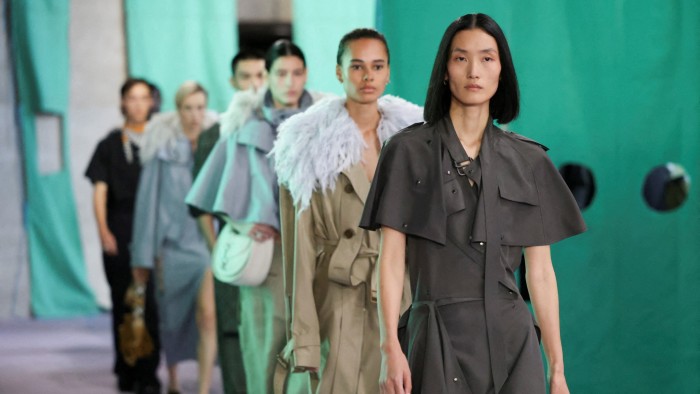
Unlock the Editor’s Digest for free
Roula Khalaf, Editor of the FT, selects her favourite stories in this weekly newsletter.
Protecting people from the weather is great business. That, at least, is what Burberry’s new chief executive Joshua Schulman believes. A promise to reverse the group’s doomed “brand elevation” strategy and return it to its trench-coat-and-scarves roots sent the stock up nearly a fifth on Thursday. A sane strategy is not a bad place to start. But it will by no means solve all of Burberry’s problems.
Schulman’s approach makes intuitive sense. That Burberry’s zany, modern and expensive products were gathering dust on shelves is clear — and was highlighted by a 20 per cent decline in first-half sales. That it might do better by selling tradition and returning prices to earth also seems reasonable: “rainwear” outperformed even during the slump, and recent campaigns that focused on traditional Britishness have been well received. Bernstein’s brand heat observatory, which tracks the attractiveness of brands on social media, shows Burberry as the biggest gainer in the third quarter of the year.
Simply backing out of this failed experiment could well staunch Burberry’s losses. The initial phase of this turnaround will not be pretty, however. Already, cost cuts and inventory provisions have lopped 6.4 percentage points off the group’s gross margin year on year. There may be more pain as Burberry discounts to clear an overhang of unsold products and restore the perception of scarcity that full-price luxury sales depend on.
The bigger concern is that the cut of Burberry’s post-turnaround coat remains fuzzy. What, for instance, is the best distribution network for a luxury coat and scarf provider? Its stores would probably struggle to generate the same sales per square foot as those of hyper-luxury handbag retailers such as Hermès and LVMH. In a world where luxury providers fight over prime locations, that may require rethinking its store footprint.
The potential size — and growth potential — of Schulman’s Burberry is also unclear. While the likes of Italy’s Moncler have redefined what it is possible to achieve with a puffer jacket heritage, British coats remain something of a niche market. Indeed, Burberry’s many reinventions stem precisely from the realisation that growth in its core segment is not limitless.
It may be possible to stretch luxury outerwear’s confines: Burberry hopes to move into expensive leather, cashmere and technical gear. Indeed, Schulman sees no reason why, over time, the group should not return to its peak £3bn turnover, or around a quarter above the sales expected this year. Schulman’s strategy has a good chance of succeeding. But returning to its roots may take Burberry back to the root of its problem.

